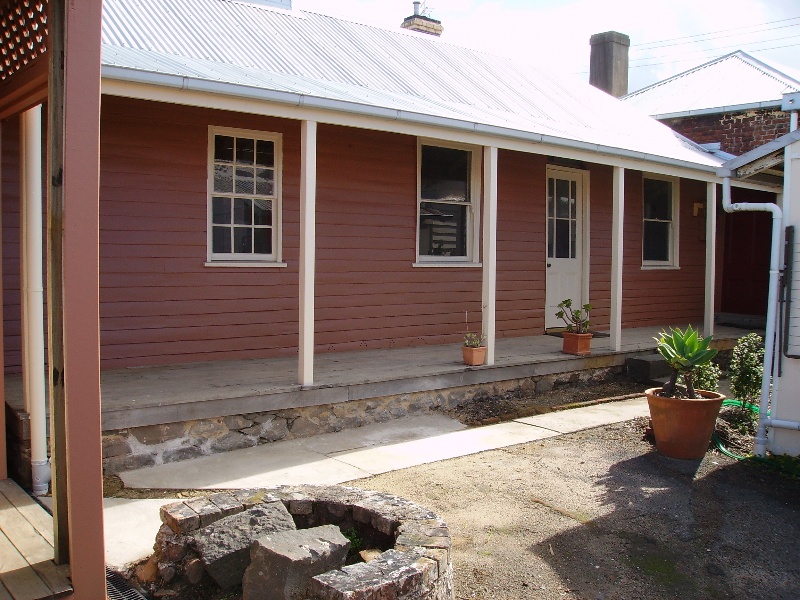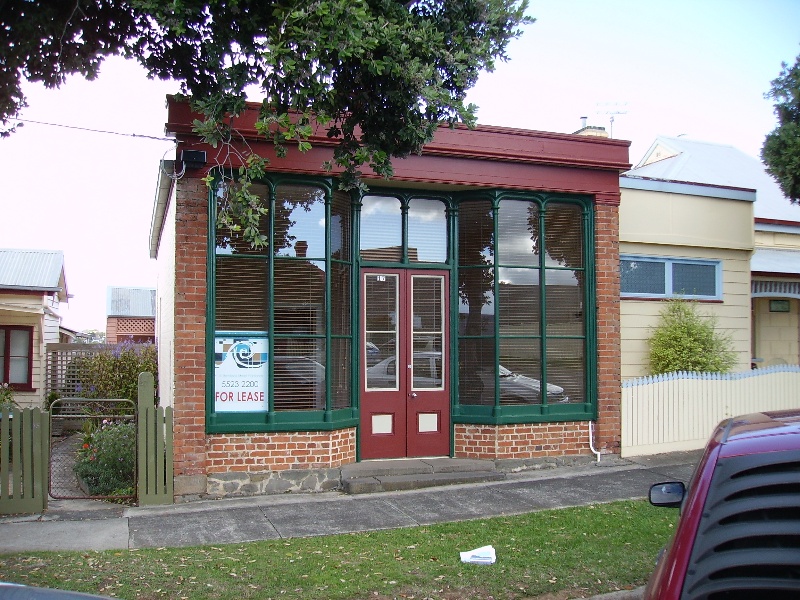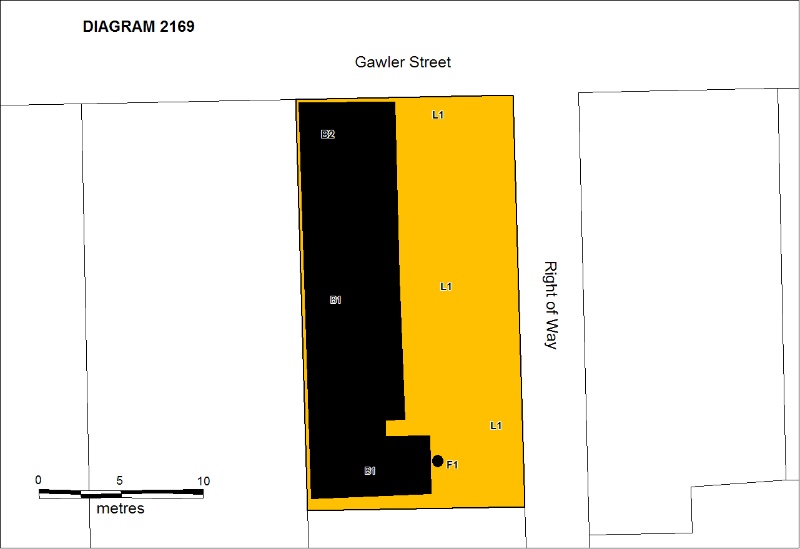COTTAGE AND SHOP
15-17 GAWLER STREET PORTLAND, GLENELG SHIRE
-
Add to tour
You must log in to do that.
-
Share
-
Shortlist place
You must log in to do that.
- Download report




Statement of Significance
What is significant?
The complex at 15-17 Gawler Street, Portland is made up of a c. 1849 weatherboard cottage, with a c. 1855 weatherboard addition and an 1860 brick and stone shop. The site is a subdivision of Lot 10, Section 2 of the 1840 town survey. Portland, the earliest permanent settlement in Victoria, developed quickly from the 1840s and its economic importance as a port grew throughout the nineteenth century. Thomas Kean, the customs boat coxswain, arrived in Portland in 1845, and moved to Gawler Street soon after 1846. He subsequently constructed a number of buildings on the site, for both residential and commercial purposes.
The three-roomed weatherboard cottage was constructed c. 1849, and consisted of a bedroom and kitchen, accessed through a central main room. Set back from Gawler Street, the residence faced east towards the bay, and is depicted on the 1853 Birmingham map of Portland, along with a smaller structure to the rear. Its simple design and hand-sawn weatherboard cladding are typical of pre-gold rush structures, and it is one of the earliest remaining buildings in Portland.
From 1852, Kean operated an 'establishment for the manufacture of tents, tarpaulins' from the property, and as his business developed, so did the buildings on the site. In 1855 tenders were advertised in 1855 for the 'building of additions to Kean's Premises in Gawler Street'. The resulting addition at the rear of the allotment began as a small weatherboard structure and at one time extended the full width of the site to the laneway. It was likely to have been associated with Kean's ships chandlery operations.
The two-roomed brick shop, facing Gawler Street, was constructed by Kean in 1860, when the area was developing as Portland's commercial district. At the time that Kean worked as a ship chandler and on customs boats, Portland was one of Victoria's major ports. It was from the Gawler Street premises he ran his 'Tent & Dray Covers' business, which operated until at least the late 1880s. The shopfront was made up of two large, wooden framed windows and a central doorway and was connected to the cottage by an internal doorway.
A number of other buildings constructed on the site during the late nineteenth century have since been demolished and a c. 1930s timber cottage now occupies the north-east corner. The c. 1855 weatherboard addition has been reduced in size since its largest incarnation stretching to the laneway by the 1870s. More recently, conservation work has been undertaken, restoring many original features.
How is it significant?
The buildings at 15-17 Gawler Street, Portland are of historical, architectural and archaeological significance to the State of Victoria.
Why is it significant?
The cottage and shop complex at 15-17 Gawler Street is of historical significance as one of the oldest remaining residential and retail premises in Portland, the earliest settlement in Victoria. The c. 1849 cottage is significant as a rare surviving example from the pre-gold rush period, and is an example of a simple dwelling style which was once common in Victoria. The complex of three buildings is significant as a whole for demonstrating the development of Portland's early commercial precinct.
The late 1840s weatherboard cottage at 15-17 Gawler Street is of architectural significance for its simple, pre-gold rush style demonstrating early building techniques and evidence of the use of recycled materials, possibly from boats. The shop is important for demonstrating typical 1860s retail design.
The site is of archaeological significance for its potential to contain deposits relating to the former use of the site for ship chandlery and residential purposes in the nineteenth century.
-
-
COTTAGE AND SHOP - History
HISTORY OF PLACE
The coast around Portland, the first settled place in Victoria, was used by whalers and sealers from as early as 1810. The Hentys arrived in the area in 1834, and were engaged in whaling activities and, with others known as the 'overstraiters' and 'overlanders', developed the Western District as pastoral country.
After the first Portland Crown Land sales in 1840, the title on the land for Section 2, Lot 10 was acquired by JA Eddie in February 1841. During the 1840s, with further land sales, Portland developed as a thriving community, and consolidated its economic importance. Thomas Kean, the customs boat coxswain, arrived in Portland in 1845, settling in an area known as Customs Point. He purchased the 'piece of land in Gawler Street' sometime after 1846. In his reminiscences, Kean recalls building the Gawler Street cottage about the same time as the Portland Customs House was constructed in 1849-50, so it is likely that this first building on the site was built in the late 1840s.
During the gold rush, with Portland suffering from a labour shortage, the Geelong and Portland Immigration Society was established, and between 1851 and 1857, over 11 000 assisted immigrants arrived in the town. In 1853, a map of the town of Portland was produced by Frederick Birmingham, detailing streets and buildings locations. Buildings were concentrated around the streets near the Customs House and jetty, in the blocks bounded by Julia, Percy, Bentick and Glenelg Streets. The map shows two structures on the Gawler Street site, set back from the street; the late 1840s cottage built by Thomas Kean and a smaller building to the rear of the site. In November 1852, the Portland Guardian noted that 'Mr. Thomas Kean has started an establishment for the manufacture of tents, tarpaulins etc [.] Apply to Thomas Kean Gawler Street' and congratulated Kean's 'spirit of enterprise'. The smaller building was perhaps associated with the ship that Kean had built in his yard in 1851 or his tent making business. In 1852, Kean was appointed the first master-lighterman in the Western District, and went on to serve as a member of the Portland borough council. In 1855, tenders were advertised for the 'building of additions to Kean's Premises in Gawler Street', likely to be the additions to the side of the late 1840s cottage. It appears that this building was constructed in stages, with additions made as required and possibly functioned as a workshop or stables.
The brick and stone shop at the front of the site was constructed in 1860 for Thomas Kean. The two roomed building was connected to the cottage through an internal doorway, and a windowed shopfront displayed the goods for sale at 'T. Kean Ship Chandler - Tent & Dray Covers' business, which he operated at least until 1888. According to the Portland Sewerage District Plan 679 of 1893 Thomas Kean was still the owner of the Gawler Street site. A photograph of Kean's premises from the 1870s depicts a number of other buildings on the site, including a two-storey stone building at the rear and another timber structure, both of which have since been demolished.
More recently, restoration work has been undertaken on the three buildings, including the removal from the shop of the wooden 'blocked' front dating from the twentieth century.
REFERENCES:
Learmonth, Noel. The Portland Bay Settlement. 1983 (reprint)
Learmonth, Noel. The Story of a Port. 1960
Wilson Sayer Pty Ltd. Portland Urban Conservation Study 1981
COTTAGE AND SHOP - Plaque Citation
Adjacent to the 1860 brick shop, the c. 1849 cottage is significant as a rare survivor from the pre-gold rush period, an example of a simple dwelling style once common in Victoria.
Updated Plaque Citation:
Cottage and Shop, 15 -17 Gawler Street, Portland
A rare pre-gold rush home, the c. 1849 cottage is an example of a simple dwelling style once common in Victoria. With the adjacent 1860 brick shop, it forms one fo the oldest remaining retail and residential complexes in Victoria's earliest permanent settlement.
COTTAGE AND SHOP - Permit Exemptions
General Exemptions:General exemptions apply to all places and objects included in the Victorian Heritage Register (VHR). General exemptions have been designed to allow everyday activities, maintenance and changes to your property, which don’t harm its cultural heritage significance, to proceed without the need to obtain approvals under the Heritage Act 2017.Places of worship: In some circumstances, you can alter a place of worship to accommodate religious practices without a permit, but you must notify the Executive Director of Heritage Victoria before you start the works or activities at least 20 business days before the works or activities are to commence.Subdivision/consolidation: Permit exemptions exist for some subdivisions and consolidations. If the subdivision or consolidation is in accordance with a planning permit granted under Part 4 of the Planning and Environment Act 1987 and the application for the planning permit was referred to the Executive Director of Heritage Victoria as a determining referral authority, a permit is not required.Specific exemptions may also apply to your registered place or object. If applicable, these are listed below. Specific exemptions are tailored to the conservation and management needs of an individual registered place or object and set out works and activities that are exempt from the requirements of a permit. Specific exemptions prevail if they conflict with general exemptions. Find out more about heritage permit exemptions here.Specific Exemptions:General Conditions: 1. All exempted alterations are to be planned and carried out in a manner which prevents damage to the fabric of the registered place or object. General Conditions: 2. Should it become apparent during further inspection or the carrying out of works that original or previously hidden or inaccessible details of the place or object are revealed which relate to the significance of the place or object, then the exemption covering such works shall cease and Heritage Victoria shall be notified as soon as possible. Note: All archaeological places have the potential to contain significant sub-surface artefacts and other remains. In most cases it will be necessary to obtain approval from the Executive Director, Heritage Victoria before the undertaking any works that have a significant sub-surface component. General Conditions: 3. If there is a conservation policy and plan endorsed by the Executive Director, all works shall be in accordance with it. Note: The existence of a Conservation Management Plan or a Heritage Action Plan endorsed by the Executive Director, Heritage Victoria provides guidance for the management of the heritage values associated with the site. It may not be necessary to obtain a heritage permit for certain works specified in the management plan. General Conditions: 4. Nothing in this determination prevents the Executive Director from amending or rescinding all or any of the permit exemptions. General Conditions: 5. Nothing in this determination exempts owners or their agents from the responsibility to seek relevant planning or building permits from the responsible authorities where applicable. Regular Site Maintenance : The following site maintenance works are permit exempt under section 66 of the Heritage Act 1995: a) regular site maintenance provided the works do not involve the removal or destruction of any significant above-ground features or sub-surface archaeological artefacts or deposits; b) the maintenance of an item to retain its conditions or operation without the removal of or damage to the existing fabric or the introduction of new materials; c) cleaning including the removal of surface deposits, organic growths, or graffiti by the use of low pressure water and natural detergents and mild brushing and scrubbing; d) repairs, conservation and maintenance to paths, fences and gates and drainage and irrigation. e) the replacement of existing services such as cabling, plumbing, wiring and fire services that uses existing routes, conduits or voids, and does not involve damage to or the removal of significant fabric. Note: Surface patina which has developed on the fabric may be an important part of the item's significance and if so needs to be preserved during maintenance and cleaning. Note: Any new materials used for repair must not exacerbate the decay of existing fabric due to chemical incompatibility, obscure existing fabric or limit access to existing fabric for future maintenance. Repair must maximise protection and retention of fabric and include the conservation of existing details or elements. Weed and Vermin Control : The following weed and vermin control activities are permit exempt under section 66 of the Heritage Act 1995, a) Weed and vermin control activities provided the works do not involve the removal or destruction of any significant above-ground features or sub-surface archaeological artefacts or deposits; Note: Particular care must be taken with weed and vermin control works where such activities may have a detrimental affect on the significant fabric of a place. Such works may include the removal of ivy, moss or lichen from an historic structure or feature, or the removal of burrows from a site that has archaeological values. Landscape Maintenance : The following landscape maintenance works are permit exempt under section 66 of the Heritage Act 1995, a) landscape maintenance works provided the activities do not involve the removal or destruction of any significant above-ground features or sub-surface archaeological artefacts or deposits; b) the process of gardening, including mowing, hedge clipping, bedding displays, removal of dead plants and replanting the same species or cultivar, disease and weed control, and maintenance to care for existing plants; c) the removal of dead or dangerous trees if the tree is an immediate risk of personal or damage to property; d) management of trees in accordance with Australian Standard; Pruning of amenity trees AS 4373. Minor Works : Note: Any Minor Works that in the opinion of the Executive Director will not adversely affect the heritage significance of the place may be exempt from the permit requirements of the Heritage Act. A person proposing to undertake minor works may submit a proposal to the Executive Director. If the Executive Director is satisfied that the proposed works will not adversely affect the heritage values of the site, the applicant may be exempted from the requirement to obtain a heritage permit. If an applicant is uncertain whether a heritage permit is required, it is recommended that the permits co-ordinator be contacted.Interior:
Painting of previously painted walls and ceilings provided that preparation or painting does not remove evidence of any original paint or other decorative scheme.Installation, removal or replacement of carpets and/or flexible floor coverings.
Installation, removal or replacement of hooks, nails and other devices for the hanging of mirrors, paintings and other wall mounted art or religious works or icons.
Installation, removal or replacement of electrical wiring.
Installation of smoke detectors.
Exterior:
Minor repairs and maintenance to buildings, structures and services within the registered land (but not new buildings and structures).Any works to non-registered buildings and structures within the extent of registration, but not additions.
COTTAGE AND SHOP - Permit Exemption Policy
Permit Policy
The purpose of the permit exemptions is to allow works that do not impact on the heritage significance of the place to occur without the need for a permit. The cultural heritage significance of 15-19 Gawler Street is as one of the oldest remaining residential and retail premises in Portland. The c. 1849 cottage is significant as a rare surviving example from the pre-gold rush period and an example of a simple dwelling style which was once common in Victoria. The shop is important for demonstrating typical 1860s retail design. Restoration work was undertaken on the shop facade in 1992, and the cottage with addition and the shop have been undergoing a program of conservation works since 2005.It is recommended that any proposed works be discussed with an officer of Heritage Victoria prior to them being undertaken or a permit is applied for. Discussing any proposed works will assist in answering any questions the owner may have and aid any decisions regarding works to the place. It is recommended that a Conservation Management Plan is undertaken to assist with the future management of the cultural significance of the place. Permits would be required for any new buildings and structures on the registered land.
The site is of archaeological significance for its potential to contain deposits relating to the former use of the site for ship chandlery and residential purposes in the nineteenth century.
Any works which disturb below ground components of the site are subject to the Executive Director's approval.
The extent of registration protects the whole site. All of the registered buildings are integral to the significance of the place and any external or internal alterations that impact on its significance are subject to permit application.
-
-
-
-
-
FORMER STEAMPACKET HOTEL
 Victorian Heritage Register H0239
Victorian Heritage Register H0239 -
LONDON INN
 Victorian Heritage Register H0237
Victorian Heritage Register H0237 -
BURSWOOD
 Victorian Heritage Register H0240
Victorian Heritage Register H0240
-
Archaeological site
 Southern Grampians Shire
Southern Grampians Shire -
Avoca
 Stonnington City H0809
Stonnington City H0809 -
BANYULE
 Victorian Heritage Register H0926
Victorian Heritage Register H0926
-
-











